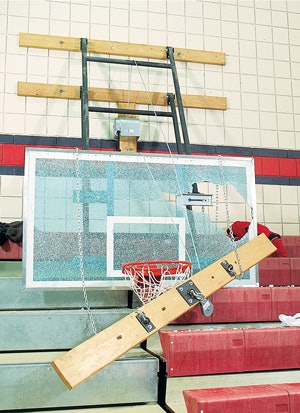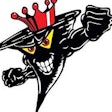When everything in a facility is in good working order and operating smoothly, it's all too easy for staff members to become complacent, trusting that everything will stay that way.
At least until something goes wrong. When dealing with the equipment in a gymnasium, particularly large, overhead components like basketball goals or gym dividers, when things go wrong, they can go very, very wrong.
"I had a conversation recently with someone who was in the middle of practice and found a bolt and nut on the floor and had no idea where it came from," says Nick Cusick, president of Lincoln, Neb.-based equipment manufacturer Bison Inc. "They had the assumption that it came from above, but they didn't see it and just went on with their business. If you see something that might be a problem, you need to investigate."
 (Checklists Courtesy of Gared) - OR - Click to enlarge
(Checklists Courtesy of Gared) - OR - Click to enlarge
TRAINED EYES
While facility employees should always have their eyes open to spot potential problems, most manufacturers recommend an in-depth inspection be conducted on a yearly basis. "Document what you find," says Cusick, " 'Here's what we looked at, here's what we found.' It helps from a risk control standpoint — if something were to happen and you had good documentation that you'd recently done an inspection, that would be helpful in mitigating risk."
Such a close inspection can be done either internally or externally, depending on the resources a facility has at its disposal. "If a facility operator has knowledgeable staff, they could do inspections internally," says Cusick. "But there are plenty of service providers out there who are regional installers and service people who come in on a fee basis and do a full gym inspection.
"Some have a fixed fee for inspection, but offer no repair," he adds. "In most areas, there's probably someone who would do a pretty thorough inspection somewhere in the $1,000 area. While that's a lot of money for a lot of facilities, it's money well spent if you don't have somebody inside who's capable."
Some equipment manufacturers also provide inspection services, including Indianapolis-based Gared Sports. Its Play RX program covers both indoor and outdoor equipment and offers three different options. "It started off as a visual inspection with checklists that can be downloaded," says sales manager Coy Porter. "The second level is a certification program for facility directors to take a written test. It goes over some of the things we feel should be looked over on a regular basis and helps them be more prepared to inspect equipment."
For operators who aren't mechanically inclined or don't have the time or resources, a third level offers inspections and repairs done by a trained and certified installation crew. Companies like Gared are also happy to help answer facility operators' questions, a task made easier by the proliferation of smart phones capable of snapping and sharing photos of problems.
"Every facility has a different staff with a different level of competency," says Porter. "Some of them are pretty talented. But if there's anything you don't feel comfortable with, you want to bring in a trained installer. It is a liability issue and safety concern."
 QUICK FIX Small details, such as a tear in a curtain or a loose screw, can be quickly and easily remedied if caught early, preventing the need for more costly fixes later. (Photo Courtesy of Gared) - OR - Click to enlarge
QUICK FIX Small details, such as a tear in a curtain or a loose screw, can be quickly and easily remedied if caught early, preventing the need for more costly fixes later. (Photo Courtesy of Gared) - OR - Click to enlarge
HEADS UP
Whether an annual inspection is done in-house or by an external professional, casual visual inspections can and should be conducted on a regular basis by facility employees. Though special training or certification shouldn't be necessary, staff members do need to know what to be looking for. The place to start is with all overhead components.
"This would be wall-mounted basketball systems or ceiling-mounted systems," says Cusick. "Some gyms have wrestling mats stored in the ceilings, divider curtains, batting cages. A high priority is to look at those overhead mounted things, anything that can fall onto the playing surface or into the bleachers. The reason why is obvious — you want to protect the players and also the fans."
"Are the cables on the ceiling system equipment frayed, are there any protrusions, broken strands, kinks?" asks Jonathan Wells, an installer and inspector with Gared. "That's something that's pretty quick and easy to inspect. If you have a service lift, you can also inspect the pulleys."
Most manufactures offer some type of backup safety device to prevent serious damage in the event of a failure. "We have a lot of safety mechanisms that keep a unit from actually ever coming off of the ceiling attachment," says Coy. "But if a cable was to break or something else was to happen, it could fall from the stored position into the playing position. It can come down quick and fast and cause some damage depending on what's in the way."
"We strongly recommend installation of a safety device," adds Cusick, noting that they are not required and thus not always purchased, but it's never too late to go back and add them.
"A cable can stretch over time," says Wells. "If there's too much slack in the cable, you go to retract and it may not retract properly. It may bind, wrap around and damage equipment. I've had to go back and adjust to take up some of that slack."
Also, pay attention to the noise the equipment makes as it's being raised or lowered into place, adds Porter. "If it makes any strange or odd noise, it could be a sign of a problem. Be aware. Listen to the equipment on a regular basis."
The hardware of other ceiling-hung components, such as divider curtains or batting cages, should also be checked, as well as the netting and fabric that makes up each. "There could be some rips that would allow a ball to pass through, which could injure a bystander," says Wells. "If there's a small rip in a vinyl curtain, a simple patch can eliminate future damage, but a small tear in the vinyl can become larger over time. Then you're talking about replacing the entire curtain."
And while it's crucial to give all of these overhead components a thorough yearly inspection, facility operators shouldn't consider the job done once the paperwork is filed. "Just because you inspect once a year does not guarantee that something isn't going to happen in the months between inspections," warns Cusick. "Take seriously the fact that you do have big heavy equipment hanging from the ceiling. If you see something that could be a concern, instead of ignoring it and saying you'll get it next year, be vigilant."
 Click to enlarge
Click to enlarge
EAR TO THE GROUND
Though the overhead components of a gymnasium may prevent the most visible risk, equipment used on the gym floor for sports like volleyball and soccer should not be forgotten.
"The volleyball stuff is less complex," says Cusick. "You don't need someone to come in from the outside to check it. When you go to set up the equipment at the beginning of the season, it's a good time to check that your net-tensioning winch is in good shape, your net is in good shape, your antennas and boundary markers aren't broken or dirty or anything like that, the officials stand isn't wobbly or needs to be replaced — those types of things."
Soccer equipment can also be inspected on a seasonal basis. "Goals should be properly anchored to prevent them from potentially falling on players and nets should be secured," says Wells. "One of the things we come across a lot is that on the bottom where the net attaches, the attachment isn't secure. Refs can miss a goal if the ball goes in but comes out the side."
Then there's the safety padding used throughout the gym on walls or backboards. "Make sure it's attached and not hanging loose, and that it's in serviceable condition to protect players," says Cusick. "Wall padding is in good shape 25 years after it's been put in as long as it's securely anchored and hasn't torn."'
Something else that's often overlooked when it comes to gym safety, says Cusick, isn't a particular gym equipment component, but rather signage spelling out what is and isn't allowed within the space. "There is value in having rules regarding the facility and having them clearly published — partially to provide real safety and partially to cover risk management," he says. "Facility operators can point to things like that that they've done to reduce the chances of injury."
 Click to enlarge
Click to enlarge
FORM AND FUNCTION
Thorough yearly inspections coupled with keen eyes can minimize the likelihood of equipment failure and injuries to users, but they also contribute to the overall gym experience. "There are two reasons to inspect equipment," says Cusick. "The highest priority is safety. The other is functionality."
Out-of-order equipment means a lost opportunity for use, not to mention contributes to a negative experience for the user. Says Porter, "With childhood obesity being the problem that it is, we want to encourage play as much as we can."
Even equipment that appears to be in good working order might not be performing at its best. Cusick suggests rotating equipment — breakaway basketball rims, for example — from high-use areas to lower-use areas. "While breakaway rims typically have a warranty, they also have a lifecycle during which they work the best," he says. "Depending on the level of play, most facilities consider replacing their breakaway rims on a 2- to 5-year cycle, or they rotate their main court rims to one of their side courts. This keeps the ball bounce off the rim consistent."
It's also easier on the facility's budget to replace such big-ticket items gradually, rather than all at once. In the end, diligence about equipment inspections and maintenance contributes to a lower bottom line overall. Says Porter, "Today's problem addressed today could save a lot of money in the long run."
This article originally appeared in the April 2014 issue of Athletic Business under the headline, "Staying Active."





































